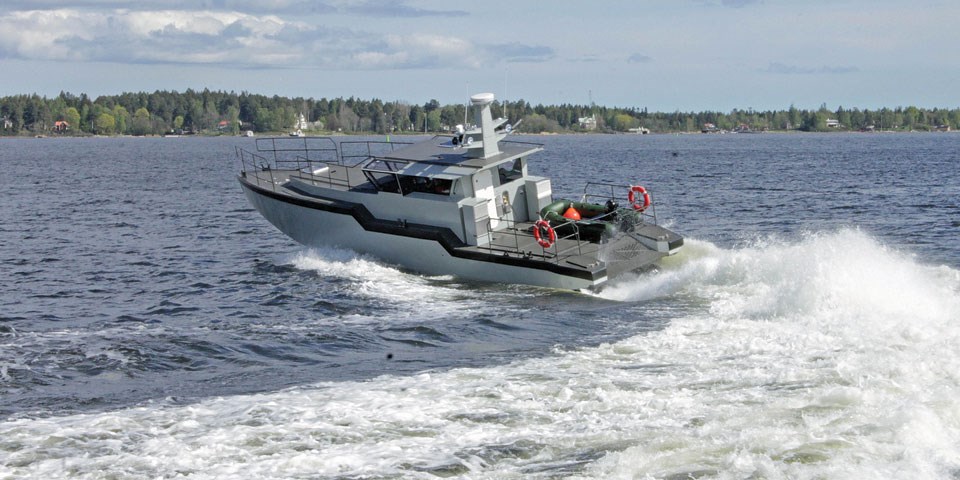Article by Daniel Sweet
___
Håkan Rosén has always taken a keen interest in sailing wooden boats. But when he first heard about Sandvik’s high-strength, super- and hyper-duplex materials, he conceived of a ship made entirely of stainless steel. This kind of vessel would be difficult to make, Rosén knew, due to its weight. But the strength of Sandvik’s super-duplex and hyper-duplex meant that less material would be needed in the finished product, and Rosén realized that an all-steel ship would be possible— if he could only come up with the appropriate design.
“Calculations for large cargo ships show a 20% saving in fuel”
Based on a technique he had learned from studying the Vikings, whose ships used efficient, flexible hulls to cut through the water, Rosén developed a prototype vessel that featured pliable hull-support stringers made from hyperduplex steel. He sources superduplex 2607 plates from Outokukmpu and hyperduplex 3207 stringers from Sandvik. This breakthrough allowed the boat frame, made from the super-duplex stainless, to glide through the water with ease. The first prototype Elvira set sail in 2014, and the P16 was launched in 2017. Since then since then, orders have poured in from businesses and governments alike. We caught up with Rosén to learn more about the benefits and manufacturing of his stainless steel ships and to hear about his company’s ambitious plans for the future.
Environmentally friendly design
When Rosén talks about the design of his ships, it doesn’t take long before he mentions the environment. And that’s because “to understand the design and benefits of stainless steel vessels, you have to look at the typical ships on the market. Take a container ship. They are heavy, and so they take much more fuel to move. On top of that you have this extremely toxic anti-fouling paint on the ship’s exterior that helps maintain the ship’s hull. With stainless steel vessels, we don’t need to worry about this. Because the super duplex ships are so much lighter and the hulls are mirror-polished below the waterline which reduces friction, they are much more efficient and environmentally friendly to run.
Calculations made for large cargo ships with an average cruise speed at 20 knots show a 20% saving in fuel used with a super-duplex hull.
Furthermore, marine organisms find it very difficult to attach to the mirror polished hulls. Any organisms which do attach to the vessel can be removed either with a low-pressure hose or even by travel at moderate speed. In general, the ship is maintenance-free, which saves precious time and money.”
Manufacturing techniques
An innovative product often requires innovative manufacturing techniques, and SSY’s stainless steel watercraft are no different. In particular, Rosèn mentioned that SSY, in conjunction with AGA gas, “has developed a secret welding gas, along with special parameters for welding the super-duplex and hyperduplex together. The process is very complicated, but we wanted to develop the best technique to get the most out of the materials. And that’s also why we have patents on everything.”
“We want to have an ethical business model. Its very important.”
Part of their patented technique also involves the use of laser welding and robotics. This has several benefits, including cost efficiency. As Rosèn said, “we’ve been working to find a production method that is efficient. This August we will implement this system at our facilities in California, USA, where we are building a number of patrol vessels. By using robots and laser welding, we are able to save on time and cost. Overall, the manufacturing processes for the duplex runs at the same cost of aluminum production. But with robots you don’t have the high costs of the highly skilled welders. That way you can spread the money around more efficiently.”
Ethical practices
Though Rosèn has found great success in the marketing and sale of his stainless steel vessels, he has also maintained his commitment to ethical business dealings. “A lot of the interest in our vessels has come from foreign militaries. But we don’t want to sell our ships to countries that are not democracies. Some of the foreign militaries are so interested in the technology, that they have made very high offers to simply buy the company. Of course this would benefit me personally, but I have said no every time. We want to have an ethical business model. It’s very important. And as we begin to expand into making larger ships like superyachts, around 130 meters long, we will need to keep this in mind.”
Offshore power & future projects
While Rosèn and SSY fulfill orders for their stainless steel vessels, they are also searching to enter other industries. In particular, “the offshore power industry, such as floating platforms for wave power stations, can also use our material,” said Rosèn. “Other materials simply do not work as well as duplex. We currently have a contract with a Swedish power company who want us to develop floating duplex hulls that should have a lifespan of 50 years. Around 100 of these huge 85 m long hulls will be used on one location. It’s a very large project requiring very durable materials. If they make them out of traditional steel, they will not last. Carbon fiber presents the same problem. But by building them out of super-duplex, we can keep the hulls in the water for the target 50 years. We are building the first prototype already, and it will be ready for testing by next year. Seven years ago I had an idea for how to use the properties of steel in a better way. I never thought it would take me this far.”


